Geometric reasoning
Term 2 starting in week 3 :: Estimated time: 2 weeks
- Angles at points (review)
- Angles in parallel lines and shapes (review)
- Exterior and interior angles of polygons
- Proving geometric facts
- Solve problems involving vectors
- Pythagoras' theorem and trigonometrical ratios (review)
For higher-attaining pupils:
- The first four circle theorems (review)
- Angle between a radius and a chord
- Angle between a radius and a tangent
- Two tangents from a point
- Alternate segment theorem
This page should remember your ticks from one visit to the next for a period of time. It does this by using Local Storage so the information is saved only on the computer you are working on right now.
Activities for pupils
Here are some related resources in alphabetical order. Some may only be appropriate for high-attaining learners while others will be useful for those in need of support. Click anywhere in the grey area to access the resource.
 Angle Points Video See a demonstration of angles in a full turn around a point, angles together on a straight line and vertically opposite angles.
Angle Points Video See a demonstration of angles in a full turn around a point, angles together on a straight line and vertically opposite angles.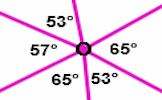 Angle Points Apply the properties of angles at a point, angles on a straight line and vertically opposite angles.
Angle Points Apply the properties of angles at a point, angles on a straight line and vertically opposite angles. Angles in a Triangle Video A reminder of how to use the fact that the angles in a triangle sum to 180 degrees to find the size of unmarked angles in triangular diagrams.
Angles in a Triangle Video A reminder of how to use the fact that the angles in a triangle sum to 180 degrees to find the size of unmarked angles in triangular diagrams.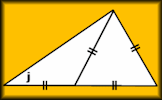 Angles in a Triangle A self marking exercise involving calculating the unknown angle in a triangle.
Angles in a Triangle A self marking exercise involving calculating the unknown angle in a triangle.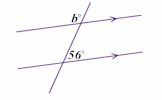 Angle Parallels Understand and use the relationship between parallel lines and alternate and corresponding angles.
Angle Parallels Understand and use the relationship between parallel lines and alternate and corresponding angles. Angle Chase Find all of the angles on the geometrical diagrams.
Angle Chase Find all of the angles on the geometrical diagrams.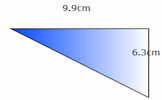 Pythagoras Basics A drill and practice self marking exercise on the basics of Pythagoras' theorem.
Pythagoras Basics A drill and practice self marking exercise on the basics of Pythagoras' theorem. Angle Theorems Diagrams of the angle theorems with interactive examples.
Angle Theorems Diagrams of the angle theorems with interactive examples. Pythagoras An online exercise to test your understanding of and ability to apply Pythagoras' Theorem.
Pythagoras An online exercise to test your understanding of and ability to apply Pythagoras' Theorem. Demonstrating Pythagoras Short clip from QI: Stephen Fry demonstrates Pythagoras' theorem.
Demonstrating Pythagoras Short clip from QI: Stephen Fry demonstrates Pythagoras' theorem. Make Them Right Arrange the measurements next to the sides of the triangles so that each diagram is correct according to Pythagoras' Theorem.
Make Them Right Arrange the measurements next to the sides of the triangles so that each diagram is correct according to Pythagoras' Theorem. Polygon Angle Explorer Barbara Bug walks around a regular hexagon turning through each of the exterior angles as she goes.
Polygon Angle Explorer Barbara Bug walks around a regular hexagon turning through each of the exterior angles as she goes. Pythagoras' Theorem Video The square of the hypotenuse of a right-angled triangle is equal to the sum of the squares of the other two sides.
Pythagoras' Theorem Video The square of the hypotenuse of a right-angled triangle is equal to the sum of the squares of the other two sides. Polygon Angles Video A concise reminder about angles, both interior and exterior, in regular and irregular polygons.
Polygon Angles Video A concise reminder about angles, both interior and exterior, in regular and irregular polygons.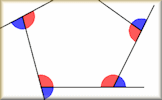 Polygon Angles A mixture of problems related to calculating the interior and exterior angles of polygons.
Polygon Angles A mixture of problems related to calculating the interior and exterior angles of polygons. Polygon Profiles A visual aid about the properties of regular polygons designed to be projected onto a whiteboard for whole class exposition.
Polygon Profiles A visual aid about the properties of regular polygons designed to be projected onto a whiteboard for whole class exposition. Angle Theorem Kim's Game A memory game to be projected to help the whole class revise the circle angle theorems.
Angle Theorem Kim's Game A memory game to be projected to help the whole class revise the circle angle theorems.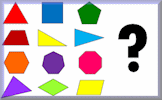 Polybragging The Transum version of the Top Trumps game played online with the properties of polygons.
Polybragging The Transum version of the Top Trumps game played online with the properties of polygons. Which Side? Arrange the diagrams in groups depending on whether the arrow is pointing to the opposite, adjacent or hypotenuse.
Which Side? Arrange the diagrams in groups depending on whether the arrow is pointing to the opposite, adjacent or hypotenuse. Trigonometry Video The basic trigonometric ratios are sine, cosine and tangent and are used to find the lengths of sides and the size of angles in right-angled triangles.
Trigonometry Video The basic trigonometric ratios are sine, cosine and tangent and are used to find the lengths of sides and the size of angles in right-angled triangles.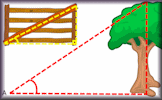 Trigonometry Sine, cosine and tangent ratios are used to find sides and angles in right-angled triangles.
Trigonometry Sine, cosine and tangent ratios are used to find sides and angles in right-angled triangles. Circle Theorems Exercise Show that you understand and can apply the circle theorems with this self marking exercise.
Circle Theorems Exercise Show that you understand and can apply the circle theorems with this self marking exercise.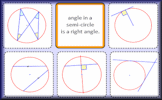 Circle Theorem Pairs A pairs game based around ten theorems about the angles made with chords, radii and tangents of circles.
Circle Theorem Pairs A pairs game based around ten theorems about the angles made with chords, radii and tangents of circles. Trig-Pythag Fusion Problems requiring multi-step solutions using both Trigonometry and Pythagoras' Theorem
Trig-Pythag Fusion Problems requiring multi-step solutions using both Trigonometry and Pythagoras' Theorem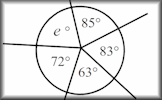 Angles Mixed Find the unknown angles by using the basic angle theorems.
Angles Mixed Find the unknown angles by using the basic angle theorems.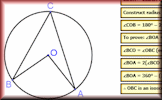 Proof of Circle Theorems Arrange the stages of the proofs for the standard circle theorems in the correct order.
Proof of Circle Theorems Arrange the stages of the proofs for the standard circle theorems in the correct order.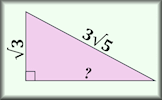 Pythagoras with Surds Questions about right-angled triangles for which the answers should be surds in their simplest form.
Pythagoras with Surds Questions about right-angled triangles for which the answers should be surds in their simplest form.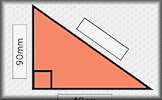 Pythagorean Probe Use Pythagoras' Theorem to help find all of the measurements of these right angles triangles.
Pythagorean Probe Use Pythagoras' Theorem to help find all of the measurements of these right angles triangles.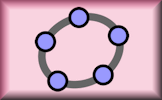 Geometry Toolbox Create your own dynamic geometrical diagrams using this truly amazing tool from GeoGebra.
Geometry Toolbox Create your own dynamic geometrical diagrams using this truly amazing tool from GeoGebra.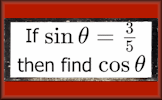 If Then Trigonometry Finding the exact values of sine, cosine and tangent of angles if given a different trig ratio.
If Then Trigonometry Finding the exact values of sine, cosine and tangent of angles if given a different trig ratio.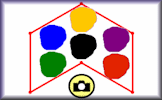 Polygon Hunting Find all the polygons that can be drawn by joining dots on this seven dot grid.
Polygon Hunting Find all the polygons that can be drawn by joining dots on this seven dot grid.
Here are some exam-style questions on this topic:
- "\(ABC\) is a right-angled triangle." ... more
- "An isosceles triangle shaped frame is made from four pieces of metal. The frame has a height of 8 metres and a base of length 12 metres." ... more
- "Work out the value of \(x\), the length in centimetres of one of the sides of this right-angled triangle." ... more
- "The exterior angle of a regular polygon is 72°" ... more
- "ABC is a right-angled triangle as shown in the diagram below. Calculate the length of AB giving your answer correct to three significant figures." ... more
- "An arborist sights the top of a tree using a clinometer and reads the angle of elevation to be 29o. Her clinometer is 28 metres from the base of the tree and is on a tripod making it 1.5 metres above ground level." ... more
- "Find the number of sides of a regular polygon with interior angle 140°" ... more
- "The diagram shows a right-angled triangle and a semicircle. The straight side of the semicircle is the same length as the longest side of the triangle." ... more
- "The diagram shows a trapezium where the sides AC and BD are parallel." ... more
- "The points B, C, D, E and F are on a circle. DAE and CAB are straight lines and AB= BE." ... more
- "Four copies of a green right-angled triangle are used to enclose a yellow square." ... more
- "The points B, C, D and E lie on the circle with centre at A." ... more
- "The diagram, not drawn to scale, show a polygon with one line of symmetry, AE." ... more
- "A number of regular pentagons and squares are arranged around the outside of a large blue regular polygon. Just the lower part of the arrangement is shown below." ... more
- "The diagram below shows two parallel lines, AB and CD, crossed by a transversal line EF. Find the values of \(w\), \(x\) and \(y\)." ... more
- "In the following diagram AD is parallel to CE and AD = CD. Angle AFD is a right angle." ... more
- "The diagram shows a quadrilateral, ABCD, formed from two triangles, ABC and ACD." ... more
- "B, C, D and E are points on the circumference of a circle, centre O." ... more
- "Points B, D, G and F lie on a circle." ... more
- "In the diagram above, not drawn to scale, A, B and C are points on a circle, centre O. TA is a tangent to the circle at A and OBT is a straight line. AC is a diameter and angle OTA = 28°." ... more
- "(a) Find \(x\), the size of angle ABC if B, C and D are all points on the circle to which AB is a tangent. The diagram is not drawn to scale." ... more
- "PQRS is a rhombus and C is the midpoint of QS." ... more
- "A triangular prism is made using two right-angled triangles and three rectangular pieces of cardboard. Five of the vertices have been labeled \(A, B, C, D \text{ and } E\) as shown in the photograph below." ... more
- "The diagram shows a circle with its centre at the origin." ... more
- "The diagram, not drawn to scale, shows chords joining points on the circumference of a circle. Prove that triangle ADE is similar to triangle BCE." ... more
- "The diagram shows a rectangular-based pyramid, TABCD (not drawn to scale)." ... more
- "The diagrams are not drawn to scale" ... more
Here are some Advanced Starters on this statement:
- Find The Radius
Find the radius of the circle from the small amount of information provided. more - Geometry Snack
Find the value of the marked angle in this diagram from the book Geometry Snacks more - Trig Blot
Find all the measurements of the given triangle. more
Click on a topic below for suggested lesson Starters, resources and activities from Transum.
- Angles Pupils should understand that angles represent an amount of turning and be able to estimate the size of angle. When constructing models and drawing pupils should be able to measure and draw angles to the nearest degree and use appropriate language associated with angles. Pupils should know the angle sums of polygons and that of angles at a point and on a straight line. They will learn about angles made in circles by chords, radii and tangents and recognise the relationships between them. Pupils will work with angles using trigonometry, transformations and bearings. In exams pupils are often instructed that while non-exact answers should be given to three significant figures, angle answers should be given to one decimal place.
- Bearings A bearing is a description of a direction. It is the number of degrees measured in a clockwise direction from north as seen from above. Convention, probably born out of the need to be quite clear when saying a bearing over a crackly aircraft radio or storm at sea, three figures are given for each bearing. So 90 degrees would be expressed as 090 degrees. The four main directions are known as the cardinal points. These are north (360°), east (090°), south (180°) and west (270°). The directions in between those are known as the half cardinal points and can be expressed as north-east (045°), south-east (135°), south-west (225°) and north west (315°). The study of bearings in Mathematics provides a practical, real-life application of angles and geometry. It can provide a need for numerical calculations, scale drawing and estimation.
- Circles This is all to do with pi and why it is such an important number. From finding the circumference and area of circles to problem solving and investigation. Pupils will begin by learning the names of the parts of a circle then, either through investigation or practical activity, discover that the circumference of a circle is always just a little more than three times the length of the diameter whatever the size of the circle. A brief walk through history leads them to find out how to use this knowledge (and a more accurate version of pi) to find the circumference and areas of circles. This can then be developed to find the area of a sector, area of a segment, area of an annulus and the area of the region between a circle and a square in more complex problem solving situations. More mathematics related to the circle can involve angle theorems, loci and algebra.
- Pythagoras Pythagoras was a Greek philosopher, mathematician, and founder of the religious movement called Pythagoreanism. He is most famous for his theorem connecting the lengths of the sides of right angled triangles. His theorem states that the squares of the lengths of the two shorter sides of any right-angled triangle will add up to the square of the length of the longest side (the hypotenuse). This theorem can be used to calculate the length of any side of a right-angled triangle if the lengths of the other two sides are known. Do you know when the next Pythagorean Day is? It will occur when the square of the day added to the square of the month equals the square of the last two digits of the year.
- Trigonometry Trigonometry is a branch of mathematics that studies triangles and the relationships between their sides and the angles between these sides. Pupils begin by learning the names on the sides of a right-angled triangle relative to the angles. They then learn the ratios of the lengths of these sides and the connection these ratios have with the size of the angles. Having mastered right-angled triangle trigonometry pupils then progress to more advanced uses including the sine rule and cosine rules. The use of a scientific or graphing calculator is essential for this topic and correct, efficient use of the calculator is an important skill to develop. Here's a Trigonometry Wordsearch just for fun.
Lesson Starters
Here are some suggestions for whole-class, projectable resources which can be used at the beginnings of each lesson in this block.
1st Lesson

Angle Estimates
Estimate the sizes of each of the angles then add your estimates together.
2nd Lesson
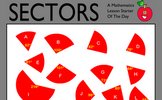
Sectors
Work out which sectors fit together to make complete circles. Knowledge of the sum of the angles at a point will help find more than one correct solution to this puzzle.
3rd Lesson
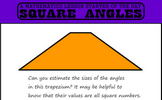
Square Angles
Find a trapezium, a triangle and a quadrilateral where all of the angles are square numbers.
4th Lesson
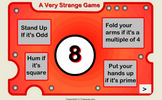
A Very Strange Game
Four different actions depending on the number which appears.
5th Lesson
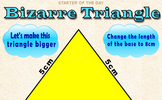
Bizarre Triangle
By how much would the area of this triangle increase if its base was enlarged to 8cm?
6th Lesson
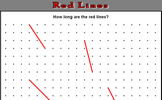
Red Lines
Either estimate the lengths of the red lines or, if you know how, calculate how long they are.
Some of the Starters above are to reinforce concepts learnt, others are to introduce new ideas while others are on unrelated topics designed for retrieval practice or and opportunity to develop problem-solving skills.

